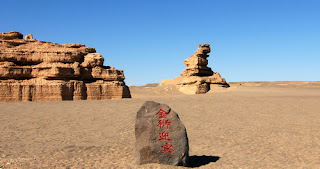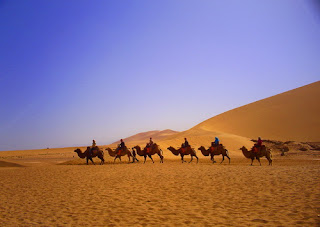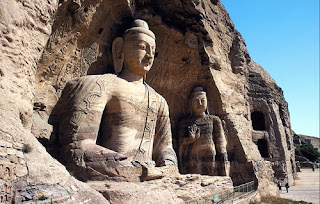Dunhuang-Ancient in Ancient
Known as Shazhou in ancient times, Dunhuang was served as a rest stop for traders as the gateway through which Buddhism, Islam and Christianity entered China.
Dunhuang is located at the western end of Hexi Corridor in Gansu Province in northwest of China. It is 2000 kilometers west of Beijing, right on the silk road that caravans would take to get from China to the Middle East.
 |
| Desert in Dunhuang |
It is a small oasis surrounded by high mountain, deserts and the Gobi Desert with Dang River as the city's water supply. The city boasts 241 places of historic interests, and many of them are world-famous for its long history, such as Mogao Grottoes, one of the greatest reminders of the silk trade in ancient time.
Other sites include the White Horse Pagoda, the Yangguan Pass and the Yumenguan Pass. These sights cannot rival in beauty with the caves, but it is quite some fun getting there through the desertlike landscape.
Dunhuang is the important ancient city in the Silk Road, and it is the hub of highway communication in the northwestern plateau in China.
Dunhuang means magnificent. In 11th century BC, some mineral nations lived here. In 111BC, the emperor of Han dynasty set up Jiuquan canton, and Dunhuang County was governed by it. The areas under Dunhuang's jurisdiction nowadays are the areas to the western and southern parts of Shule River in Gansu.
 |
| Ride a Camel in the Desert |
From the two Hans to Southern and Northern Dynasties, Dunhuang was the thoroughfare between the middle part and the western part. The government of Dunhuang changed many times, but Dunhuang was always the capital of county, government office, town and province. And at that time, it was called Dunhuang or Shazhou.
In Song dynasty, it belonged to Western Hsia, and province was abolished. In Ming dynasty and Qing dynasty, Shazhou was changed into a province, later on; it was changed into Dunhuang province.
In Dunhuang, there are a lot of historical relics. Such as Mogao Caves, (it is called thousands of Buddha caves), it has 1500 years' history. It is in the important place in Chinese history.
Mogao Caves
Mogao Caves is a UNESCO World Heritage Site filled with exquisite Buddhist art and Manuscripts. Situated at a strategic point along the Silk Route, at the crossroads of trade as well as religious, cultural and intellectual influences, the 492 cells and cave sanctuaries in Mogao are famous for their statues and well paintings, spanning 1,000 years of Buddhist art.
The grottoes in the Mogao Caves are the world's largest and oldest treasure house of Buddhist art.
 |
| Mogao Caves |
It also known as the One-Thousand-Buddha Grottoes, are located on the eastern, rocky side of Singing Sand Mountain, near Dunhang City, Gansu Province. According to historical records, the carving of them was started in 366 AD and continued for about 1,000 years.
Now, there are 492 grottoes in existence, with some 45,000 square m of murals and 2,400-odd painted clay figures. The painted clay figures vary greatly in size, with the largest one being 33 m high and the smallest only 10 cm.
Painted clay sculptures and murals in the Mogao Grottoes have mainly Buddhist themes, but they also include human figures, reflecting various societies and cultures of different times. Besides, they also demonstrate painting styles of different times in layout, figure design, delineation and coloring, as well as the integration of Chinese and Western arts.
In 1900, a total of 4,500 valuable cultural relics dating from 256 AD to 1002 were found in the Buddhist Sutra Cave here, including silk paintings, embroidery and documents in rare languages such as ancient Tibetan and Sanskrit. This is regarded as one of the world's greatest Oriental cultural discoveries.
 |
| Buddharupa |
The Mogao Grottoes show examples of various types of art, such as architecture, painting and statuary. By inheriting the artistic traditions of the central and western regions of China and absorbing the merits of ancient arts from India, Greece and Iran, ancient Chinese artists created Buddhist art works with strong local features. These art works are treasures of human civilization, providing valuable material for studies of the politics, economy, culture, religion, ethnic relations and foreign exchanges of China in olden times. Besides, there are also about 50,000 items of scriptures, documents, paintings and weavings written in several languages spanning the period from the Three Kingdoms Period to Northern Song Dynasty.
Grottoes: so far there are 492 grottoes, with murals and painted clay figures. There are meditation grottoes, Buddha hall grottoes, temple grottoes, vault-roofed grottoes and shadow grottoes. The largest grotto is 40 m high and 30 m wide, whereas the smallest is less than one foot high.
Painted Clay Figures: these are the main treasures of the Dunhuang Grottoes. The figures are in different forms, including round figures and relief figures. The tallest is 34.5 m high, while the smallest is only 2 cm. These painted clay figures show such a great variety of themes and subject matter, as well as advanced techniques, that the Mogao Grottoes are generally regarded as the world's leading museum of Buddhist painted clay figures.
 |
| Euphratica |
Murals: the murals in the Mogao Grottoes display Buddhist sutras, natural scenery, buildings, mountain and water paintings, flower patterns, flying Apsaras (Buddhist fairies) and ancient farming and production scenes. There are 1,045 murals extant, with a total area of 45,000 sq. m. They are artistic records of historical changes and customs and traditions from the 4th to the 18th centuries.
Excavated Articles: in 1900, about 50,000 cultural relics were found in a sanctum sealed behind the northern wall of Grotto No. 16. These articles included Buddhist sutras, documents, embroidery works and paintings from the 4th to the 12th centuries. Apart from ancient Chinese documents, there were also documents in other ancient languages, including Tibetan, Sanskrit and Uygur. The subjects of these documents include religion, literature, contracts, ledgers and official files. This discovery, which attracted world attention, is of great research value for supplementing and emending ancient Chinese documents.
--All in all, Dunhuang is like an arts palace and cultural house. There are Chinese ancient buildings, paintings and carvings. The ancient place of Yumenguan was the important pass of the northern part of the Silk Road.
Travel Tips for Dunhuang
Deserts, gobi, oasis, mountains and lakes are all shown in this area, and they enhance beauty of each other with fertile farmlands and abundant natural resources. The average height above the sea level in Dunhuang is 1,138 meters. It covers altogether 312,000 square kilometers.
The Danghe River, which is originated from the glacier in Qilian Mountains, runs through the whole oasis with endless stream. It is 390 kilometers in length with a runoff of 0.328 billion cubic meters per year. So it can irrigate 300,000mu fertile farmlands.
Climate: Dunhuang, being surrounded by high mountains, has an arid, continental climate. The annual average temperature is 9.3 °C (48.7 °F), but ranges from 24.7 °C (76.5 °F) in July to −9.3 °C (15 °F) in January. Dunhuang is extremely hot in summer and bitterly cold in winter. Precipitation occurs only in trace amounts and quickly evaporates.
No comments:
Post a Comment
Thanks for your comment and welcome to China!